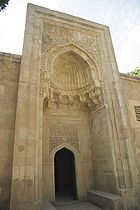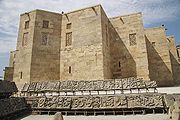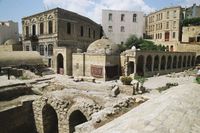
Palace of the Shirvanshahs
Encyclopedia
Palace of the Shirvanshahs (or Shirvanshahs' Palace; ) is the biggest monument of the Shirvan-Absheron branch of the Azerbaijan
architecture, situated in the Inner City of Baku
. The complex contains the main building of the palace, Divanhane, the burial-vaults
, the shah's mosque with a minaret, Seyid Yahya Bakuvi's mausoleum, a portal in the east - Murad's gate, a reservoir and the remnants of the bath-house.
The palace is depicted on the obverse
of the Azerbaijani 10,000 manat
banknote of 1994-2006, and of the 10 new manat banknote issued since 2006.
dynasty under Ibrahim I of Shirvan
transferred his country's capital from Shemakha to Baku, and committed himself to the construction of the "palace". The building is believed to be a memorial complex built around the sacred place of worship
(pir
) and a tomb
of Seyyid Yahya Bakuvi who was a Helwati Sufi saint. The Shirvanshahs were patrons of the Helwati Sufi order and Shirvanshah Khalilullah I
was buried with his family in the grounds of the palace. Other historians argue that the building was used as the ruler's palace, however both theories suffer from the absence of evidence. It is known however, that wells inside the grounds of the "palace" were considered to have healing qualities until recent times, as was the hill where the palace was built.
After the Safavid conquest of Baku in 1501, the Sufi order was expelled and over centuries the "palace" fell into ruin, and was known in Baku as Baku Khans palace; this toponym moved into Russian historiography, first cited by Bartold.
 Divankhana is a small stone pavilion. It is situated inside a small courtyard surrounded by a gallery-arcade on three sides. The Divankhana pavilion consists of an octahedral hall covered with a stone cupola both inside and outside. The well-proportioned high portal of the main entrance is decorated with an ornament and Arabic inscription. The ornament pictures the interlacing fig and vine leaves. The portal is also decorated with two medallions inside of which there are inscriptions in Kufic
Divankhana is a small stone pavilion. It is situated inside a small courtyard surrounded by a gallery-arcade on three sides. The Divankhana pavilion consists of an octahedral hall covered with a stone cupola both inside and outside. The well-proportioned high portal of the main entrance is decorated with an ornament and Arabic inscription. The ornament pictures the interlacing fig and vine leaves. The portal is also decorated with two medallions inside of which there are inscriptions in Kufic
Arabic.
The Mausoleum of the Shirvanshahs is of a rectangular shape and crowned with a hexahedral cupola which is decorated from outside with multi-radial stars. The inscription on the entrance doorway indicates the purpose of the building, "Khalilullah I, the greatest Soltan, Great Shirvanshah, the namesake of the divine prophet, the defender of the religion ordered to construct this light burial-vault for his mother and son in 839" (1435–1436). On two drop-shaped medallions in the flannel parts of the portal there are inscriptions with the architect's name - Memar Ali (architect Ali).
The Palace Mosque (1430s) is situated in the lower court of the complex. The laconicism of its prismatic volumes, completed with two slightly pointed cupolas, is shaded by a well-proportioned vertical line of the minaret rising above in the north-eastern corner of the building. There are 2 chapels for prayers in the mosque: a hall of a large size for men and a hall of a small size for women, also a couple of small subsidiary rooms. There is an inscription laid under the stalactite belt of the minaret which reads, "The greatest Soltan Khalilullah I
ordered to build this minaret. May Allah
exalt the days of his governing and reign. The year of 845" (1441–1442).
Seyid Yahya Bakuvi's Mausoleum is situated in the southern part of the complex. Seyid Yahya Bakuvi was a royal scholar in the court of Shirvanshah Khalilullah. The Mausoleum is of an octahedral shape and covered with an octahedral marquee. It consists of ground and underground parts. The upper part of the Mausoleum served to perform the cult rites, and the lower one housed the sepulchral vault. There are three small lancet window
s with a stone bar - shabaka on the southern, eastern and western verges of the Mausoleum.
The Shirvanshahs' Palace complex also includes the portal of Eastern Gates, the so-called "Sultan Murad's Gate" (1585). It was built within the walls of the citadel rather later than all the other constructions of the complex during Ottoman occupation of 1585-1603rd century. The gates were named by them in honor of Sultan Murad III
.
The Palace Bath-house is situated on the lowest terrace of the complex. It was discovered in 1939 and dates to 17th century. The archaeological excavations exposed a big bath-house consisting of 26 rooms. On the basis of the surviving remains of the walls of the bath-house one can say that its rooms used to be covered with cupolas and the light penetrated through the openings in the cupolas. The bath-house was semi-underground for keeping the heat in winter and the cool in summer.
The Shirvanshahs' Palace complex was declared a museum-reserve in 1964 and was taken under the state protection. Major restoration works are ongoing.
Azerbaijan
Azerbaijan , officially the Republic of Azerbaijan is the largest country in the Caucasus region of Eurasia. Located at the crossroads of Western Asia and Eastern Europe, it is bounded by the Caspian Sea to the east, Russia to the north, Georgia to the northwest, Armenia to the west, and Iran to...
architecture, situated in the Inner City of Baku
Baku
Baku , sometimes spelled as Baki or Bakou, is the capital and largest city of Azerbaijan, as well as the largest city on the Caspian Sea and of the Caucasus region. It is located on the southern shore of the Absheron Peninsula, which projects into the Caspian Sea. The city consists of two principal...
. The complex contains the main building of the palace, Divanhane, the burial-vaults
Burial vault (tomb)
A burial vault is a structural underground tomb.It is a stone or brick-lined underground space or 'burial' chamber for the interment of a dead body or bodies. They were originally and are still often vaulted and usually have stone slab entrances...
, the shah's mosque with a minaret, Seyid Yahya Bakuvi's mausoleum, a portal in the east - Murad's gate, a reservoir and the remnants of the bath-house.
The palace is depicted on the obverse
Obverse and reverse
Obverse and its opposite, reverse, refer to the two flat faces of coins and some other two-sided objects, including paper money, flags , seals, medals, drawings, old master prints and other works of art, and printed fabrics. In this usage, obverse means the front face of the object and reverse...
of the Azerbaijani 10,000 manat
Azerbaijani manat
The Manat is the currency of Azerbaijan. It is subdivided into 100 qəpik. The word manat is borrowed from "moneta" which is pronounced as "maneta"...
banknote of 1994-2006, and of the 10 new manat banknote issued since 2006.
History
In the 15th century the ShirvanshahShirvanshah
Shirvanshah also spelled as Shīrwān Shāh or Sharwān Shāh, was the title in mediaeval Islamic times of an Arab in Ethnos but speedily Persianized dynasty within their culturally Persian environment. The Shirvanshah established a native state in Shirvan...
dynasty under Ibrahim I of Shirvan
Ibrahim I of Shirvan
Ibrahim I of Shirvan Shirvanshah was a ruler of Shirvan from the Derbendid dynasty.After the death of Shirvanshah Hushang in 1382, Ibrahim I was selected to be the ruler by the local nobility. At the time, he was an impoverished noble living in Shaki...
transferred his country's capital from Shemakha to Baku, and committed himself to the construction of the "palace". The building is believed to be a memorial complex built around the sacred place of worship
Place of worship
A place of worship or house of worship is an establishment or her location where a group of people comes to perform acts of religious study, honor, or devotion. The form and function of religious architecture has evolved over thousands of years for both changing beliefs and architectural style...
(pir
Pir
-Finance:Pir may refer to:* Pier 1 Imports Stock symbol NYSE:PIR, a Texas-based retailer specializing in imported home furnishings and decor-Economics:PIR may refer to:* poverty index ratio, a measure of income relative to U.S...
) and a tomb
Tomb
A tomb is a repository for the remains of the dead. It is generally any structurally enclosed interment space or burial chamber, of varying sizes...
of Seyyid Yahya Bakuvi who was a Helwati Sufi saint. The Shirvanshahs were patrons of the Helwati Sufi order and Shirvanshah Khalilullah I
Khalilullah I
Khalilullah I was ruler of Shirvan and son of Ibrahim I of Shirvan. He was succeeded by Shirvanshah Farrukh Yassar, his son....
was buried with his family in the grounds of the palace. Other historians argue that the building was used as the ruler's palace, however both theories suffer from the absence of evidence. It is known however, that wells inside the grounds of the "palace" were considered to have healing qualities until recent times, as was the hill where the palace was built.
After the Safavid conquest of Baku in 1501, the Sufi order was expelled and over centuries the "palace" fell into ruin, and was known in Baku as Baku Khans palace; this toponym moved into Russian historiography, first cited by Bartold.
Architecture
The main building of the complex was started in 1411 by Shirvanshah Sheykh Ibrahim I. The two-storey building of the palace numbers about 50 different dimensions and outlines of the constructions connected with 3 narrow winding staircases. The big lancet portal directly leads from the courtyard to the second floor, into a high octahedral lodging covered with a cupola. A small, also an octagonal vestibule, located behind it, connects it with the rest of the lodgings in the palace.
Kufic
Kufic is the oldest calligraphic form of the various Arabic scripts and consists of a modified form of the old Nabataean script. Its name is derived from the city of Kufa, Iraq, although it was known in Mesopotamia at least 100 years before the foundation of Kufa. At the time of the emergence of...
Arabic.
The Mausoleum of the Shirvanshahs is of a rectangular shape and crowned with a hexahedral cupola which is decorated from outside with multi-radial stars. The inscription on the entrance doorway indicates the purpose of the building, "Khalilullah I, the greatest Soltan, Great Shirvanshah, the namesake of the divine prophet, the defender of the religion ordered to construct this light burial-vault for his mother and son in 839" (1435–1436). On two drop-shaped medallions in the flannel parts of the portal there are inscriptions with the architect's name - Memar Ali (architect Ali).
The Palace Mosque (1430s) is situated in the lower court of the complex. The laconicism of its prismatic volumes, completed with two slightly pointed cupolas, is shaded by a well-proportioned vertical line of the minaret rising above in the north-eastern corner of the building. There are 2 chapels for prayers in the mosque: a hall of a large size for men and a hall of a small size for women, also a couple of small subsidiary rooms. There is an inscription laid under the stalactite belt of the minaret which reads, "The greatest Soltan Khalilullah I
Khalilullah I
Khalilullah I was ruler of Shirvan and son of Ibrahim I of Shirvan. He was succeeded by Shirvanshah Farrukh Yassar, his son....
ordered to build this minaret. May Allah
Allah
Allah is a word for God used in the context of Islam. In Arabic, the word means simply "God". It is used primarily by Muslims and Bahá'ís, and often, albeit not exclusively, used by Arabic-speaking Eastern Catholic Christians, Maltese Roman Catholics, Eastern Orthodox Christians, Mizrahi Jews and...
exalt the days of his governing and reign. The year of 845" (1441–1442).
Seyid Yahya Bakuvi's Mausoleum is situated in the southern part of the complex. Seyid Yahya Bakuvi was a royal scholar in the court of Shirvanshah Khalilullah. The Mausoleum is of an octahedral shape and covered with an octahedral marquee. It consists of ground and underground parts. The upper part of the Mausoleum served to perform the cult rites, and the lower one housed the sepulchral vault. There are three small lancet window
Lancet window
A lancet window is a tall narrow window with a pointed arch at its top. It acquired the "lancet" name from its resemblance to a lance. Instances of this architectural motif are most often found in Gothic and ecclesiastical structures, where they are often placed singly or in pairs.The motif first...
s with a stone bar - shabaka on the southern, eastern and western verges of the Mausoleum.
The Shirvanshahs' Palace complex also includes the portal of Eastern Gates, the so-called "Sultan Murad's Gate" (1585). It was built within the walls of the citadel rather later than all the other constructions of the complex during Ottoman occupation of 1585-1603rd century. The gates were named by them in honor of Sultan Murad III
Murad III
Murad III was the Sultan of the Ottoman Empire from 1574 until his death.-Biography:...
.
The Palace Bath-house is situated on the lowest terrace of the complex. It was discovered in 1939 and dates to 17th century. The archaeological excavations exposed a big bath-house consisting of 26 rooms. On the basis of the surviving remains of the walls of the bath-house one can say that its rooms used to be covered with cupolas and the light penetrated through the openings in the cupolas. The bath-house was semi-underground for keeping the heat in winter and the cool in summer.
The Shirvanshahs' Palace complex was declared a museum-reserve in 1964 and was taken under the state protection. Major restoration works are ongoing.
 |
 |
 |
See also
- ShirvanshahShirvanshahShirvanshah also spelled as Shīrwān Shāh or Sharwān Shāh, was the title in mediaeval Islamic times of an Arab in Ethnos but speedily Persianized dynasty within their culturally Persian environment. The Shirvanshah established a native state in Shirvan...
- AzerbaijanAzerbaijanAzerbaijan , officially the Republic of Azerbaijan is the largest country in the Caucasus region of Eurasia. Located at the crossroads of Western Asia and Eastern Europe, it is bounded by the Caspian Sea to the east, Russia to the north, Georgia to the northwest, Armenia to the west, and Iran to...
- Maiden Tower (Baku)Maiden Tower (Baku)The Maiden Tower or also known locally as Giz Galasi located in the Old City, Baku in Azerbaijan is an ancient tower with cultural affinity corroborating the presence Zoroastrians, Sassanians, Arabs, Persians, Shirvanis, Ottomans, and Russians...
- List of World Heritage Sites in Azerbaijan

